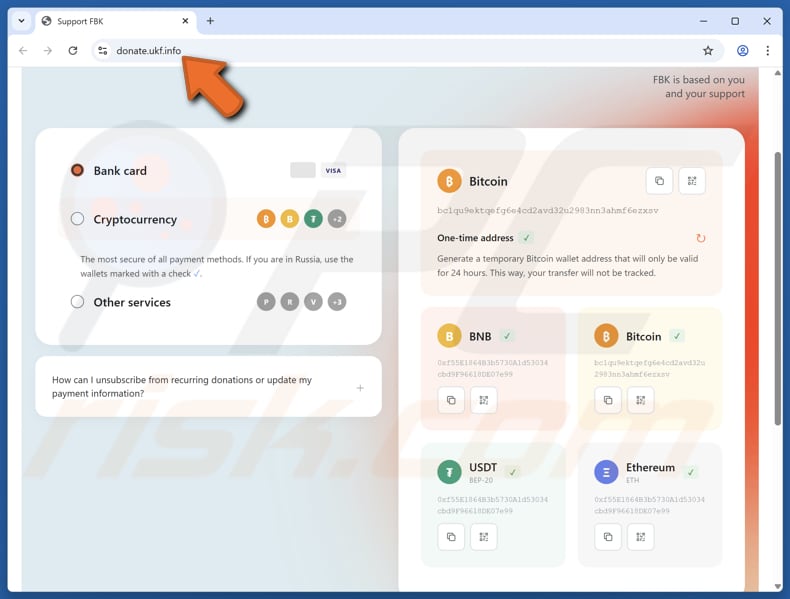How to identify scams like "Food For The Poor"
Phishing/ScamAlso Known As: Food For The Poor donation scam
Get free scan and check if your device is infected.
Remove it nowTo use full-featured product, you have to purchase a license for Combo Cleaner. Seven days free trial available. Combo Cleaner is owned and operated by RCS LT, the parent company of PCRisk.com.
What is "Food For The Poor" scam?
We have inspected the email and found that it is a classic donation scam. It leads to a website designed to steal cryptocurrency (the site may be hijacked by scammers). Emails like this one should be ignored to avoid cryptocurrency theft and possibly other issues (e.g., identity theft).

More about the "Food For The Poor" scam email
The email mentions a humanitarian crisis involving Christians in Nigeria and claims that government-supported extremist violence has left communities without food, shelter, or medical care. It asks for donations, pushing recipients to send cryptocurrency through one-time Bitcoin addresses.
The email also misuses the name of a known organization (Anti-Corruption Foundation) to appear legitimate and includes a link to donate ("Donate Here"). On the provided website, individuals are offered different payment methods and provided with cryptocurrency wallets to make "donations". The provided crypto wallets are owned by fraudsters.
If someone sends money to the scammers, the payment is almost always lost permanently, as crypto transactions cannot be reversed. It is also important to note that falling for this scam can lead to further attempts to extract more money or personal details (e.g., personal identification information). Thus, anyone who receives this email should ignore it.
| Name | Food For The Poor Email Scam |
| Threat Type | Phishing, Scam, Social Engineering, Fraud |
| Fake Claim | Donations are urgently needed to provide food, shelter, and medical aid |
| Disguise | Message from the Anti-Corruption Foundation |
| Related Domain | donate.ukf[.]info |
| Detection Names | Fortinet (Spam), Full List Of Detections (VirusTotal) |
| Scammer's Crypto Wallets | 0xf55E1864B3b5730A1d53034cbd9F96618DE07e99, bc1qu9ektqefg6e4cd2avd32u2983nn3ahmf6ezxsv |
| Symptoms | Unauthorized online purchases, changed online account passwords, identity theft, illegal access of the computer. |
| Distribution methods | Deceptive emails, rogue online pop-up ads, search engine poisoning techniques, misspelled domains. |
| Damage | Loss of sensitive private information, monetary loss, identity theft. |
| Malware Removal (Windows) |
To eliminate possible malware infections, scan your computer with legitimate antivirus software. Our security researchers recommend using Combo Cleaner. Download Combo CleanerTo use full-featured product, you have to purchase a license for Combo Cleaner. 7 days free trial available. Combo Cleaner is owned and operated by RCS LT, the parent company of PCRisk.com. |
Similar scam emails in general
Scams of this type use fake stories to convince potential victims to send money or provide sensitive information. They often claim to come from charities, public figures, or trusted organizations to appear legitimate. Such scams should be ignored, deleted, and reported.
Some examples of similar scams are "Donation To Someone With Good Intentions", "Binance Charity - California Wildfires Fundraiser", and "Older Person To Retrieve Money From The Bank". Sometimes, cybercriminals can use deceptive emails to trick recipients into executing malware on their devices.
How do spam campaigns infect computers?
Threat actors deliver malware via email by including malicious attachments or links. These attachments are usually compromised PDFs, Office documents, scripts, executable files, or archives such as ZIP and RAR.
Malware can be activated when a user opens an infected file, enables macros in a compromised document, or takes other actions. Scam emails may also lead recipients to unsafe websites, which can automatically download malware or trick users into downloading and running it.
How to avoid installation of malware?
Always download software and files from official websites or app stores, and avoid using pirated software, cracking tools, or key generators. Be cautious with irrelevant or unsolicited emails and messages that include attachments or links, especially if they come from unknown senders.
Regularly update your operating system and all applications. Avoid clicking on ads, links, pop-ups, and other content on dubious websites, and do not allow these sites to send notifications. Use a reliable security tool and run regular system scans.
The appearance of the scam email (GIF):

Text presented in the "Food For The Poor" email letter:
Subject: HELPING THE CHRISTAINS IN NIGERIA
FOOD FOR THE POOR
Mass Suffering of Christains in NigeriaDear brothers/sisters and lovers of truth.
Its it heavy heart that we are sending you this message, its no longer news that there is a state sponsored Islamic genocide going on in Nigeria ,where thousands are been slaughtered daily. In the last 10 years over a million Christian have been killed by Boko Haram. SWAP and other radical Islamic terrorists with the active backing of both the central and state government.
The homes and communities of those who were able to escape the marauding islamists were burnt and consistently attacked to make sure no one came back to the community, the only semblance of life in northern Nigeria for the abandoned Christian community is in the Internally Displaced People camp, provided by NGO.There is no food, shelter, sanitary or medical supplies in the camp ,hence starvation and diseases are ravaging the already traumatized Christian community with cholera, malaria and other sickness prevalent.
We are asking for donations from kind hearted people to be able to provide for this endangered Christian community as echoed by President Donald Trump, every little contribution will go a long way to helping the Christian of northern Nigeria.
God bless you.
Donate Here
Cryptocurrency is particularly essential for this mission. To enhance security, we've implemented a feature to generate a one-time Bitcoin address, making it harder to trace such transactions.
Even small donations matter. We're determined to provide food and other basic amenities to this religiously percecuted . With your support, we'll do everything in our power to ensure that justice prevails.Thanks for being part of the Anti Corruption Foundation.
For a free and happy World - FBK is based on you and your support
Website used to steal cryptocurrency (the site may be hacked):

Instant automatic malware removal:
Manual threat removal might be a lengthy and complicated process that requires advanced IT skills. Combo Cleaner is a professional automatic malware removal tool that is recommended to get rid of malware. Download it by clicking the button below:
DOWNLOAD Combo CleanerBy downloading any software listed on this website you agree to our Privacy Policy and Terms of Use. To use full-featured product, you have to purchase a license for Combo Cleaner. 7 days free trial available. Combo Cleaner is owned and operated by RCS LT, the parent company of PCRisk.com.
Quick menu:
- What is Food For The Poor donation scam?
- Types of malicious emails.
- How to spot a malicious email?
- What to do if you fell for an email scam?
Types of malicious emails:
![]() Phishing Emails
Phishing Emails
Most commonly, cybercriminals use deceptive emails to trick Internet users into giving away their sensitive private information, for example, login information for various online services, email accounts, or online banking information.
Such attacks are called phishing. In a phishing attack, cybercriminals usually send an email message with some popular service logo (for example, Microsoft, DHL, Amazon, Netflix), create urgency (wrong shipping address, expired password, etc.), and place a link which they hope their potential victims will click on.
After clicking the link presented in such email message, victims are redirected to a fake website that looks identical or extremely similar to the original one. Victims are then asked to enter their password, credit card details, or some other information that gets stolen by cybercriminals.
![]() Emails with Malicious Attachments
Emails with Malicious Attachments
Another popular attack vector is email spam with malicious attachments that infect users' computers with malware. Malicious attachments usually carry trojans that are capable of stealing passwords, banking information, and other sensitive information.
In such attacks, cybercriminals' main goal is to trick their potential victims into opening an infected email attachment. To achieve this goal, email messages usually talk about recently received invoices, faxes, or voice messages.
If a potential victim falls for the lure and opens the attachment, their computers get infected, and cybercriminals can collect a lot of sensitive information.
While it's a more complicated method to steal personal information (spam filters and antivirus programs usually detect such attempts), if successful, cybercriminals can get a much wider array of data and can collect information for a long period of time.
![]() Sextortion Emails
Sextortion Emails
This is a type of phishing. In this case, users receive an email claiming that a cybercriminal could access the webcam of the potential victim and has a video recording of one's masturbation.
To get rid of the video, victims are asked to pay a ransom (usually using Bitcoin or another cryptocurrency). Nevertheless, all of these claims are false - users who receive such emails should ignore and delete them.
How to spot a malicious email?
While cyber criminals try to make their lure emails look trustworthy, here are some things that you should look for when trying to spot a phishing email:
- Check the sender's ("from") email address: Hover your mouse over the "from" address and check if it's legitimate. For example, if you received an email from Microsoft, be sure to check if the email address is @microsoft.com and not something suspicious like @m1crosoft.com, @microsfot.com, @account-security-noreply.com, etc.
- Check for generic greetings: If the greeting in the email is "Dear user", "Dear @youremail.com", "Dear valued customer", this should raise suspiciousness. Most commonly, companies call you by your name. Lack of this information could signal a phishing attempt.
- Check the links in the email: Hover your mouse over the link presented in the email, if the link that appears seems suspicious, don't click it. For example, if you received an email from Microsoft and the link in the email shows that it will go to firebasestorage.googleapis.com/v0... you shouldn't trust it. It's best not to click any links in the emails but to visit the company website that sent you the email in the first place.
- Don't blindly trust email attachments: Most commonly, legitimate companies will ask you to log in to their website and to view any documents there; if you received an email with an attachment, it's a good idea to scan it with an antivirus application. Infected email attachments are a common attack vector used by cybercriminals.
To minimise the risk of opening phishing and malicious emails we recommend using Combo Cleaner Antivirus for Windows.
Example of a spam email:

What to do if you fell for an email scam?
- If you clicked on a link in a phishing email and entered your password - be sure to change your password as soon as possible. Usually, cybercriminals collect stolen credentials and then sell them to other groups that use them for malicious purposes. If you change your password in a timely manner, there's a chance that criminals won't have enough time to do any damage.
- If you entered your credit card information - contact your bank as soon as possible and explain the situation. There's a good chance that you will need to cancel your compromised credit card and get a new one.
- If you see any signs of identity theft - you should immediately contact the Federal Trade Commission. This institution will collect information about your situation and create a personal recovery plan.
- If you opened a malicious attachment - your computer is probably infected, you should scan it with a reputable antivirus application. For this purpose, we recommend using Combo Cleaner Antivirus for Windows.
- Help other Internet users - report phishing emails to Anti-Phishing Working Group, FBI’s Internet Crime Complaint Center, National Fraud Information Center and U.S. Department of Justice.
Frequently Asked Questions (FAQ)
Why did I receive this email?
Usually, scammers send identical emails to a large number of people. These messages are generic, and scammers hope that at least someone will fall for them.
I have provided my personal information when tricked by this email, what should I do?
If any account login details have been shared, update compromised passwords. If other personal information, like credit card information or ID details, has been disclosed, notify the relevant authorities immediately.
I have downloaded and opened a malicious file attached to an email, is my computer infected?
Executable files can launch malware as soon as they are opened. Documents and other file types usually require the user to enable macros or perform additional steps before the malware becomes active. Thus, the likelihood of infection depends on the file type.
I have sent cryptocurrency to the address presented in such email, can I get my money back?
Unfortunately, cryptocurrency transactions are irreversible, so once cryptocurrency is sent to the scammer's address, it cannot be recovered.
I have read the email but did not open the attachment, is my computer infected?
A device can only be compromised if the user opens a malicious attachment or clicks on a link included in the fraudulent message. Opening emails is not harmful.
Will Combo Cleaner remove malware infections that were present in email attachment?
Combo Cleaner is capable of detecting and removing most known malware. Since sophisticated malware can hide deep within the system, it is important to run a full system scan.
Share:

Tomas Meskauskas
Expert security researcher, professional malware analyst
I am passionate about computer security and technology. I have an experience of over 10 years working in various companies related to computer technical issue solving and Internet security. I have been working as an author and editor for pcrisk.com since 2010. Follow me on Twitter and LinkedIn to stay informed about the latest online security threats.
PCrisk security portal is brought by a company RCS LT.
Joined forces of security researchers help educate computer users about the latest online security threats. More information about the company RCS LT.
Our malware removal guides are free. However, if you want to support us you can send us a donation.
DonatePCrisk security portal is brought by a company RCS LT.
Joined forces of security researchers help educate computer users about the latest online security threats. More information about the company RCS LT.
Our malware removal guides are free. However, if you want to support us you can send us a donation.
Donate
▼ Show Discussion